Reviewing ETDs and OTC Derivatives in Financial Risk Management
VerifiedAdded on 2022/09/03
|9
|1829
|19
Literature Review
AI Summary
This literature review provides an overview of exchange traded derivatives (ETDs) and over-the-counter (OTC) derivatives, highlighting their key differences, similarities, and uses in financial risk management. It discusses the growth of exchange traded derivatives, particularly in comparison to the OTC market, where commercial banks dominate currency derivatives trading. The review covers the advantages and disadvantages of each type, including transparency, counterparty risk, and transaction costs. It also touches on empirical work and findings related to the use of ETDs and OTC derivatives for speculation and risk management, emphasizing the importance of transparency and regulation in these markets. The document concludes by referencing several academic papers and resources used in the analysis.
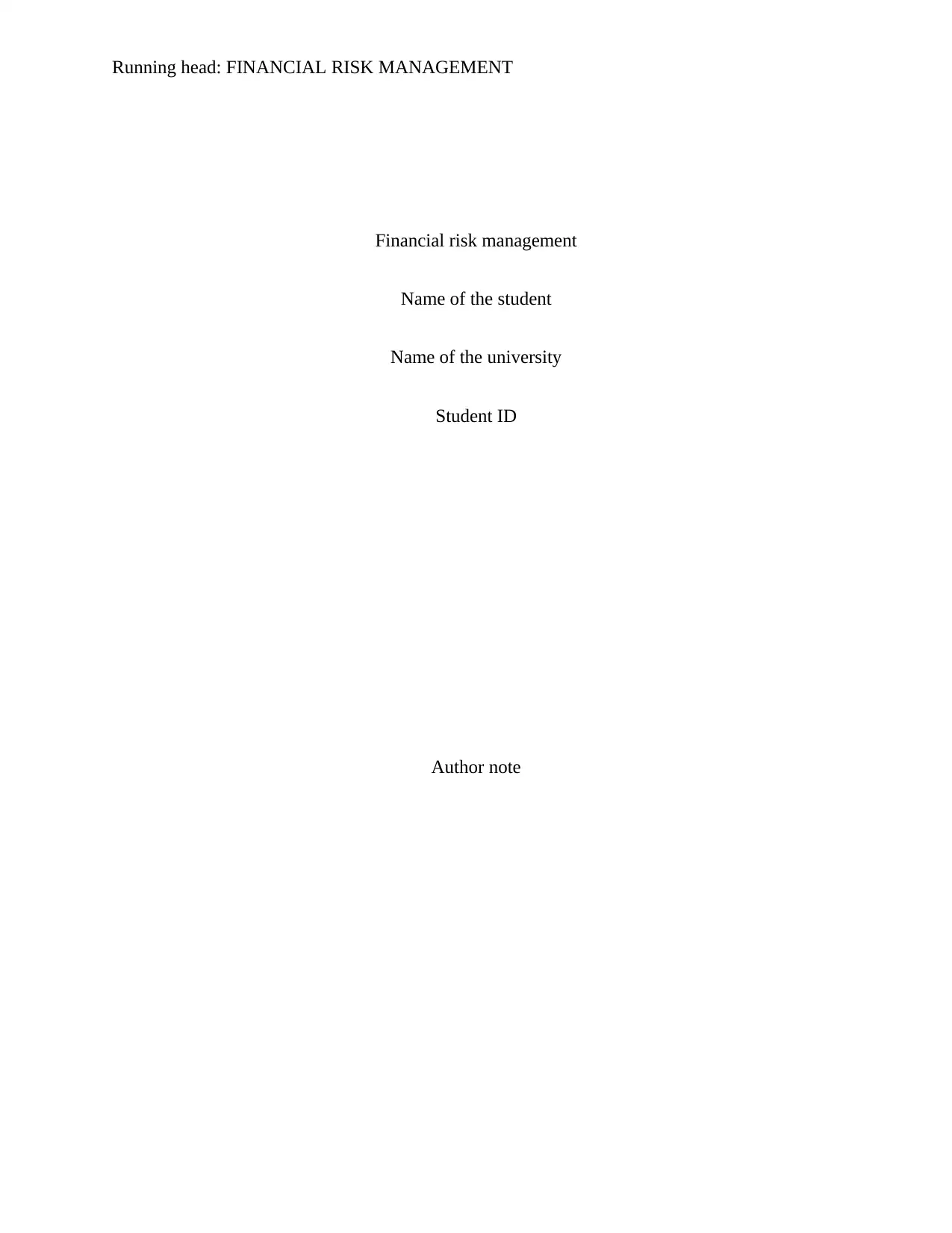
Running head: FINANCIAL RISK MANAGEMENT
Financial risk management
Name of the student
Name of the university
Student ID
Author note
Financial risk management
Name of the student
Name of the university
Student ID
Author note
Paraphrase This Document
Need a fresh take? Get an instant paraphrase of this document with our AI Paraphraser
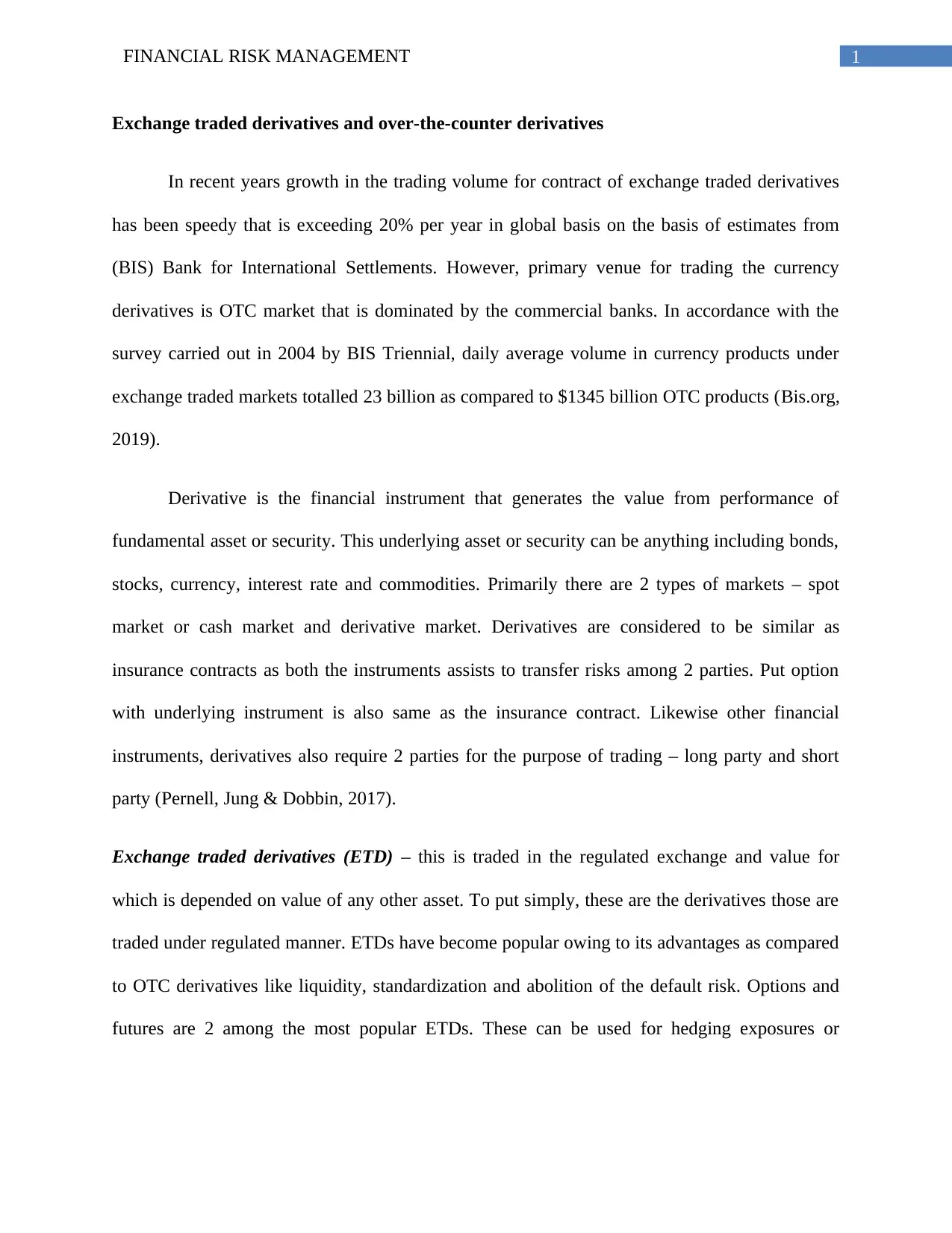
1FINANCIAL RISK MANAGEMENT
Exchange traded derivatives and over-the-counter derivatives
In recent years growth in the trading volume for contract of exchange traded derivatives
has been speedy that is exceeding 20% per year in global basis on the basis of estimates from
(BIS) Bank for International Settlements. However, primary venue for trading the currency
derivatives is OTC market that is dominated by the commercial banks. In accordance with the
survey carried out in 2004 by BIS Triennial, daily average volume in currency products under
exchange traded markets totalled 23 billion as compared to $1345 billion OTC products (Bis.org,
2019).
Derivative is the financial instrument that generates the value from performance of
fundamental asset or security. This underlying asset or security can be anything including bonds,
stocks, currency, interest rate and commodities. Primarily there are 2 types of markets – spot
market or cash market and derivative market. Derivatives are considered to be similar as
insurance contracts as both the instruments assists to transfer risks among 2 parties. Put option
with underlying instrument is also same as the insurance contract. Likewise other financial
instruments, derivatives also require 2 parties for the purpose of trading – long party and short
party (Pernell, Jung & Dobbin, 2017).
Exchange traded derivatives (ETD) – this is traded in the regulated exchange and value for
which is depended on value of any other asset. To put simply, these are the derivatives those are
traded under regulated manner. ETDs have become popular owing to its advantages as compared
to OTC derivatives like liquidity, standardization and abolition of the default risk. Options and
futures are 2 among the most popular ETDs. These can be used for hedging exposures or
Exchange traded derivatives and over-the-counter derivatives
In recent years growth in the trading volume for contract of exchange traded derivatives
has been speedy that is exceeding 20% per year in global basis on the basis of estimates from
(BIS) Bank for International Settlements. However, primary venue for trading the currency
derivatives is OTC market that is dominated by the commercial banks. In accordance with the
survey carried out in 2004 by BIS Triennial, daily average volume in currency products under
exchange traded markets totalled 23 billion as compared to $1345 billion OTC products (Bis.org,
2019).
Derivative is the financial instrument that generates the value from performance of
fundamental asset or security. This underlying asset or security can be anything including bonds,
stocks, currency, interest rate and commodities. Primarily there are 2 types of markets – spot
market or cash market and derivative market. Derivatives are considered to be similar as
insurance contracts as both the instruments assists to transfer risks among 2 parties. Put option
with underlying instrument is also same as the insurance contract. Likewise other financial
instruments, derivatives also require 2 parties for the purpose of trading – long party and short
party (Pernell, Jung & Dobbin, 2017).
Exchange traded derivatives (ETD) – this is traded in the regulated exchange and value for
which is depended on value of any other asset. To put simply, these are the derivatives those are
traded under regulated manner. ETDs have become popular owing to its advantages as compared
to OTC derivatives like liquidity, standardization and abolition of the default risk. Options and
futures are 2 among the most popular ETDs. These can be used for hedging exposures or
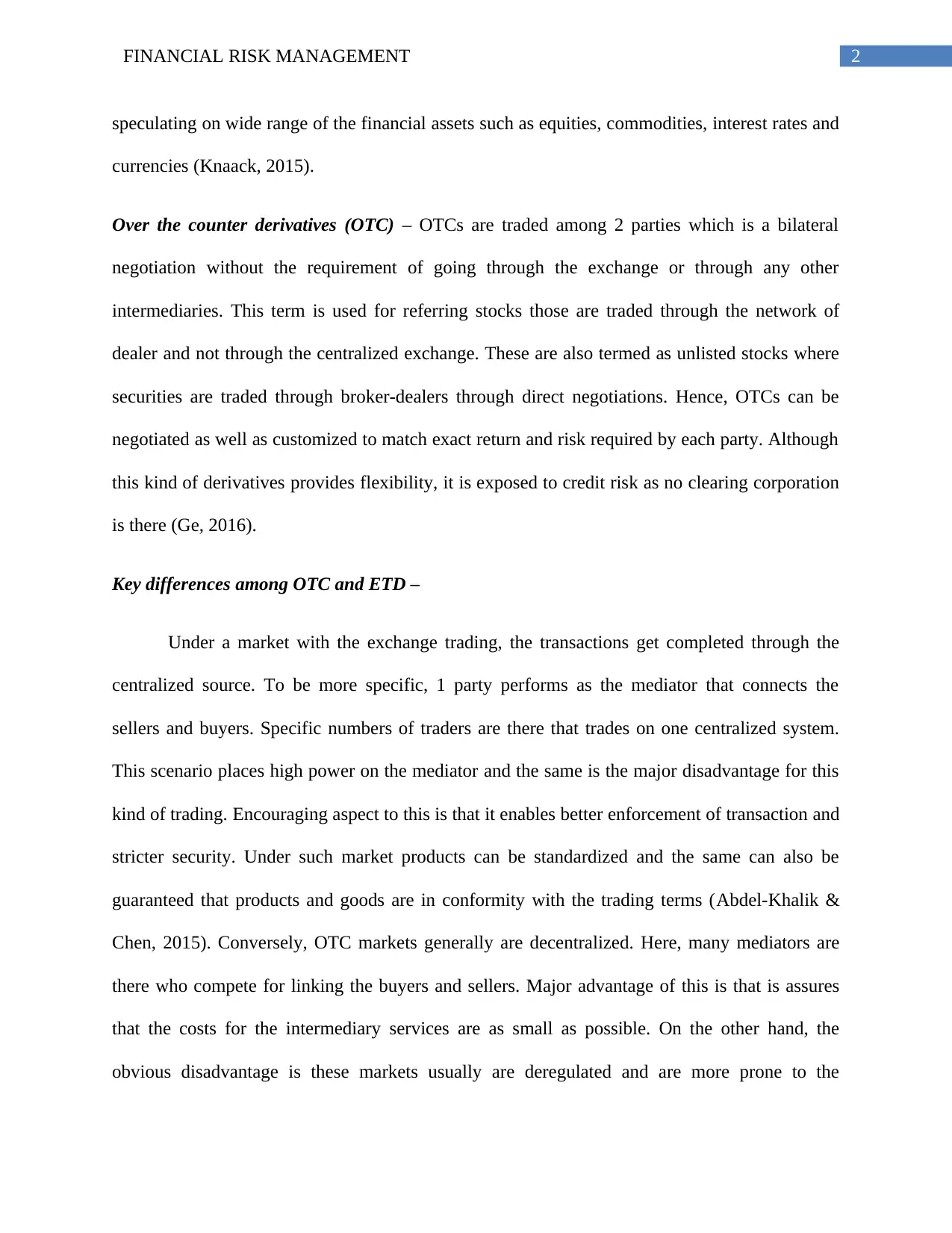
2FINANCIAL RISK MANAGEMENT
speculating on wide range of the financial assets such as equities, commodities, interest rates and
currencies (Knaack, 2015).
Over the counter derivatives (OTC) – OTCs are traded among 2 parties which is a bilateral
negotiation without the requirement of going through the exchange or through any other
intermediaries. This term is used for referring stocks those are traded through the network of
dealer and not through the centralized exchange. These are also termed as unlisted stocks where
securities are traded through broker-dealers through direct negotiations. Hence, OTCs can be
negotiated as well as customized to match exact return and risk required by each party. Although
this kind of derivatives provides flexibility, it is exposed to credit risk as no clearing corporation
is there (Ge, 2016).
Key differences among OTC and ETD –
Under a market with the exchange trading, the transactions get completed through the
centralized source. To be more specific, 1 party performs as the mediator that connects the
sellers and buyers. Specific numbers of traders are there that trades on one centralized system.
This scenario places high power on the mediator and the same is the major disadvantage for this
kind of trading. Encouraging aspect to this is that it enables better enforcement of transaction and
stricter security. Under such market products can be standardized and the same can also be
guaranteed that products and goods are in conformity with the trading terms (Abdel-Khalik &
Chen, 2015). Conversely, OTC markets generally are decentralized. Here, many mediators are
there who compete for linking the buyers and sellers. Major advantage of this is that is assures
that the costs for the intermediary services are as small as possible. On the other hand, the
obvious disadvantage is these markets usually are deregulated and are more prone to the
speculating on wide range of the financial assets such as equities, commodities, interest rates and
currencies (Knaack, 2015).
Over the counter derivatives (OTC) – OTCs are traded among 2 parties which is a bilateral
negotiation without the requirement of going through the exchange or through any other
intermediaries. This term is used for referring stocks those are traded through the network of
dealer and not through the centralized exchange. These are also termed as unlisted stocks where
securities are traded through broker-dealers through direct negotiations. Hence, OTCs can be
negotiated as well as customized to match exact return and risk required by each party. Although
this kind of derivatives provides flexibility, it is exposed to credit risk as no clearing corporation
is there (Ge, 2016).
Key differences among OTC and ETD –
Under a market with the exchange trading, the transactions get completed through the
centralized source. To be more specific, 1 party performs as the mediator that connects the
sellers and buyers. Specific numbers of traders are there that trades on one centralized system.
This scenario places high power on the mediator and the same is the major disadvantage for this
kind of trading. Encouraging aspect to this is that it enables better enforcement of transaction and
stricter security. Under such market products can be standardized and the same can also be
guaranteed that products and goods are in conformity with the trading terms (Abdel-Khalik &
Chen, 2015). Conversely, OTC markets generally are decentralized. Here, many mediators are
there who compete for linking the buyers and sellers. Major advantage of this is that is assures
that the costs for the intermediary services are as small as possible. On the other hand, the
obvious disadvantage is these markets usually are deregulated and are more prone to the
⊘ This is a preview!⊘
Do you want full access?
Subscribe today to unlock all pages.

Trusted by 1+ million students worldwide
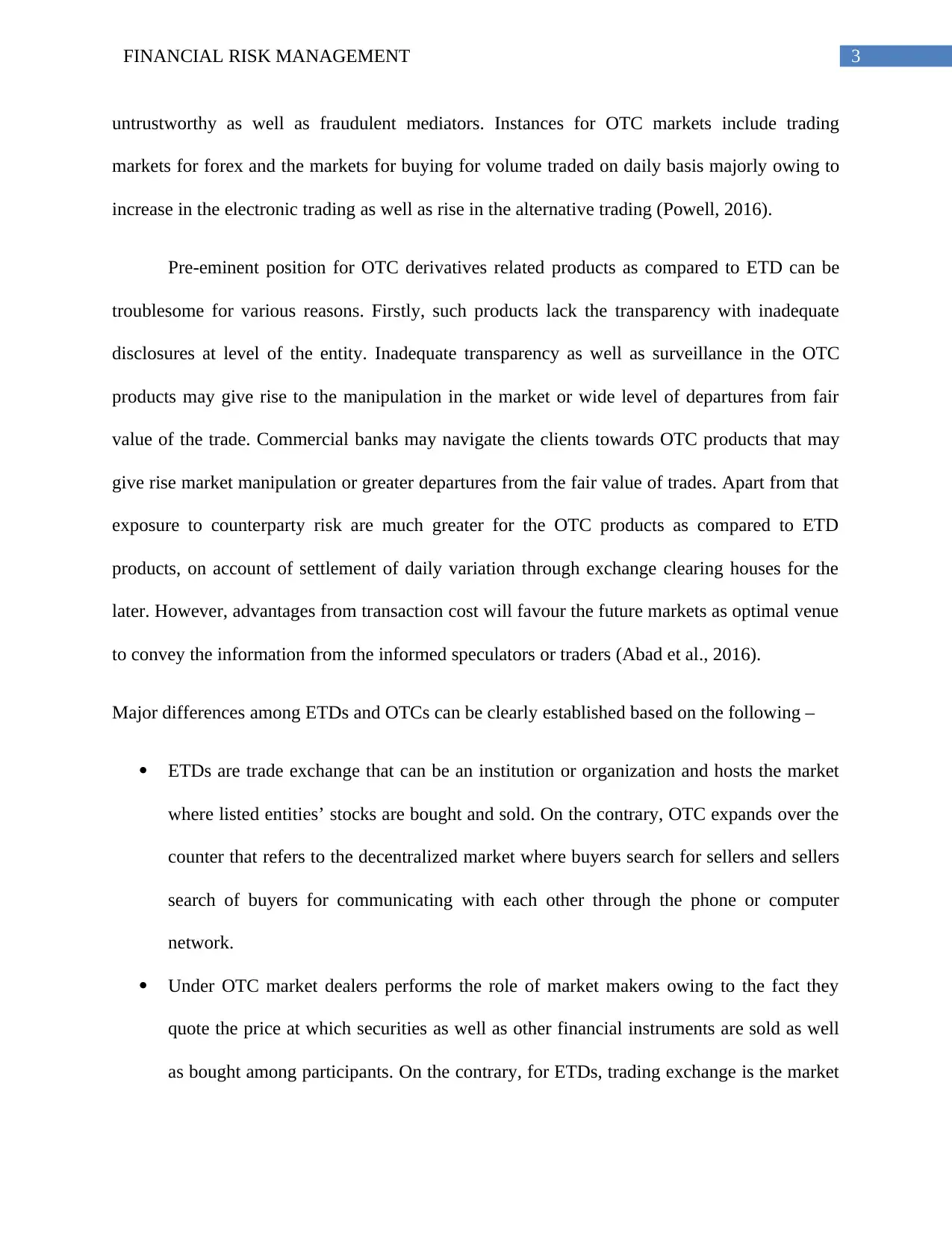
3FINANCIAL RISK MANAGEMENT
untrustworthy as well as fraudulent mediators. Instances for OTC markets include trading
markets for forex and the markets for buying for volume traded on daily basis majorly owing to
increase in the electronic trading as well as rise in the alternative trading (Powell, 2016).
Pre-eminent position for OTC derivatives related products as compared to ETD can be
troublesome for various reasons. Firstly, such products lack the transparency with inadequate
disclosures at level of the entity. Inadequate transparency as well as surveillance in the OTC
products may give rise to the manipulation in the market or wide level of departures from fair
value of the trade. Commercial banks may navigate the clients towards OTC products that may
give rise market manipulation or greater departures from the fair value of trades. Apart from that
exposure to counterparty risk are much greater for the OTC products as compared to ETD
products, on account of settlement of daily variation through exchange clearing houses for the
later. However, advantages from transaction cost will favour the future markets as optimal venue
to convey the information from the informed speculators or traders (Abad et al., 2016).
Major differences among ETDs and OTCs can be clearly established based on the following –
ETDs are trade exchange that can be an institution or organization and hosts the market
where listed entities’ stocks are bought and sold. On the contrary, OTC expands over the
counter that refers to the decentralized market where buyers search for sellers and sellers
search of buyers for communicating with each other through the phone or computer
network.
Under OTC market dealers performs the role of market makers owing to the fact they
quote the price at which securities as well as other financial instruments are sold as well
as bought among participants. On the contrary, for ETDs, trading exchange is the market
untrustworthy as well as fraudulent mediators. Instances for OTC markets include trading
markets for forex and the markets for buying for volume traded on daily basis majorly owing to
increase in the electronic trading as well as rise in the alternative trading (Powell, 2016).
Pre-eminent position for OTC derivatives related products as compared to ETD can be
troublesome for various reasons. Firstly, such products lack the transparency with inadequate
disclosures at level of the entity. Inadequate transparency as well as surveillance in the OTC
products may give rise to the manipulation in the market or wide level of departures from fair
value of the trade. Commercial banks may navigate the clients towards OTC products that may
give rise market manipulation or greater departures from the fair value of trades. Apart from that
exposure to counterparty risk are much greater for the OTC products as compared to ETD
products, on account of settlement of daily variation through exchange clearing houses for the
later. However, advantages from transaction cost will favour the future markets as optimal venue
to convey the information from the informed speculators or traders (Abad et al., 2016).
Major differences among ETDs and OTCs can be clearly established based on the following –
ETDs are trade exchange that can be an institution or organization and hosts the market
where listed entities’ stocks are bought and sold. On the contrary, OTC expands over the
counter that refers to the decentralized market where buyers search for sellers and sellers
search of buyers for communicating with each other through the phone or computer
network.
Under OTC market dealers performs the role of market makers owing to the fact they
quote the price at which securities as well as other financial instruments are sold as well
as bought among participants. On the contrary, for ETDs, trading exchange is the market
Paraphrase This Document
Need a fresh take? Get an instant paraphrase of this document with our AI Paraphraser
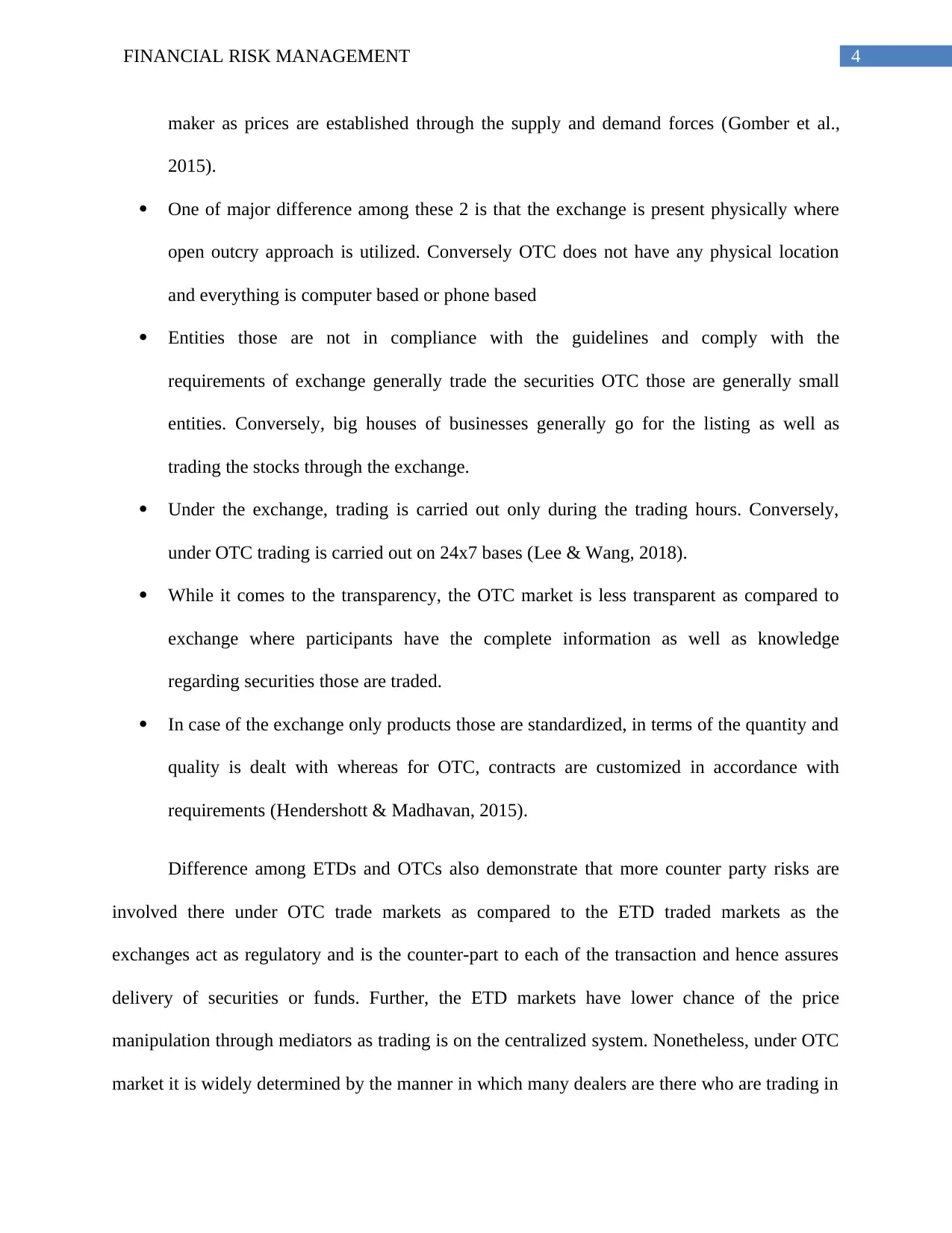
4FINANCIAL RISK MANAGEMENT
maker as prices are established through the supply and demand forces (Gomber et al.,
2015).
One of major difference among these 2 is that the exchange is present physically where
open outcry approach is utilized. Conversely OTC does not have any physical location
and everything is computer based or phone based
Entities those are not in compliance with the guidelines and comply with the
requirements of exchange generally trade the securities OTC those are generally small
entities. Conversely, big houses of businesses generally go for the listing as well as
trading the stocks through the exchange.
Under the exchange, trading is carried out only during the trading hours. Conversely,
under OTC trading is carried out on 24x7 bases (Lee & Wang, 2018).
While it comes to the transparency, the OTC market is less transparent as compared to
exchange where participants have the complete information as well as knowledge
regarding securities those are traded.
In case of the exchange only products those are standardized, in terms of the quantity and
quality is dealt with whereas for OTC, contracts are customized in accordance with
requirements (Hendershott & Madhavan, 2015).
Difference among ETDs and OTCs also demonstrate that more counter party risks are
involved there under OTC trade markets as compared to the ETD traded markets as the
exchanges act as regulatory and is the counter-part to each of the transaction and hence assures
delivery of securities or funds. Further, the ETD markets have lower chance of the price
manipulation through mediators as trading is on the centralized system. Nonetheless, under OTC
market it is widely determined by the manner in which many dealers are there who are trading in
maker as prices are established through the supply and demand forces (Gomber et al.,
2015).
One of major difference among these 2 is that the exchange is present physically where
open outcry approach is utilized. Conversely OTC does not have any physical location
and everything is computer based or phone based
Entities those are not in compliance with the guidelines and comply with the
requirements of exchange generally trade the securities OTC those are generally small
entities. Conversely, big houses of businesses generally go for the listing as well as
trading the stocks through the exchange.
Under the exchange, trading is carried out only during the trading hours. Conversely,
under OTC trading is carried out on 24x7 bases (Lee & Wang, 2018).
While it comes to the transparency, the OTC market is less transparent as compared to
exchange where participants have the complete information as well as knowledge
regarding securities those are traded.
In case of the exchange only products those are standardized, in terms of the quantity and
quality is dealt with whereas for OTC, contracts are customized in accordance with
requirements (Hendershott & Madhavan, 2015).
Difference among ETDs and OTCs also demonstrate that more counter party risks are
involved there under OTC trade markets as compared to the ETD traded markets as the
exchanges act as regulatory and is the counter-part to each of the transaction and hence assures
delivery of securities or funds. Further, the ETD markets have lower chance of the price
manipulation through mediators as trading is on the centralized system. Nonetheless, under OTC
market it is widely determined by the manner in which many dealers are there who are trading in
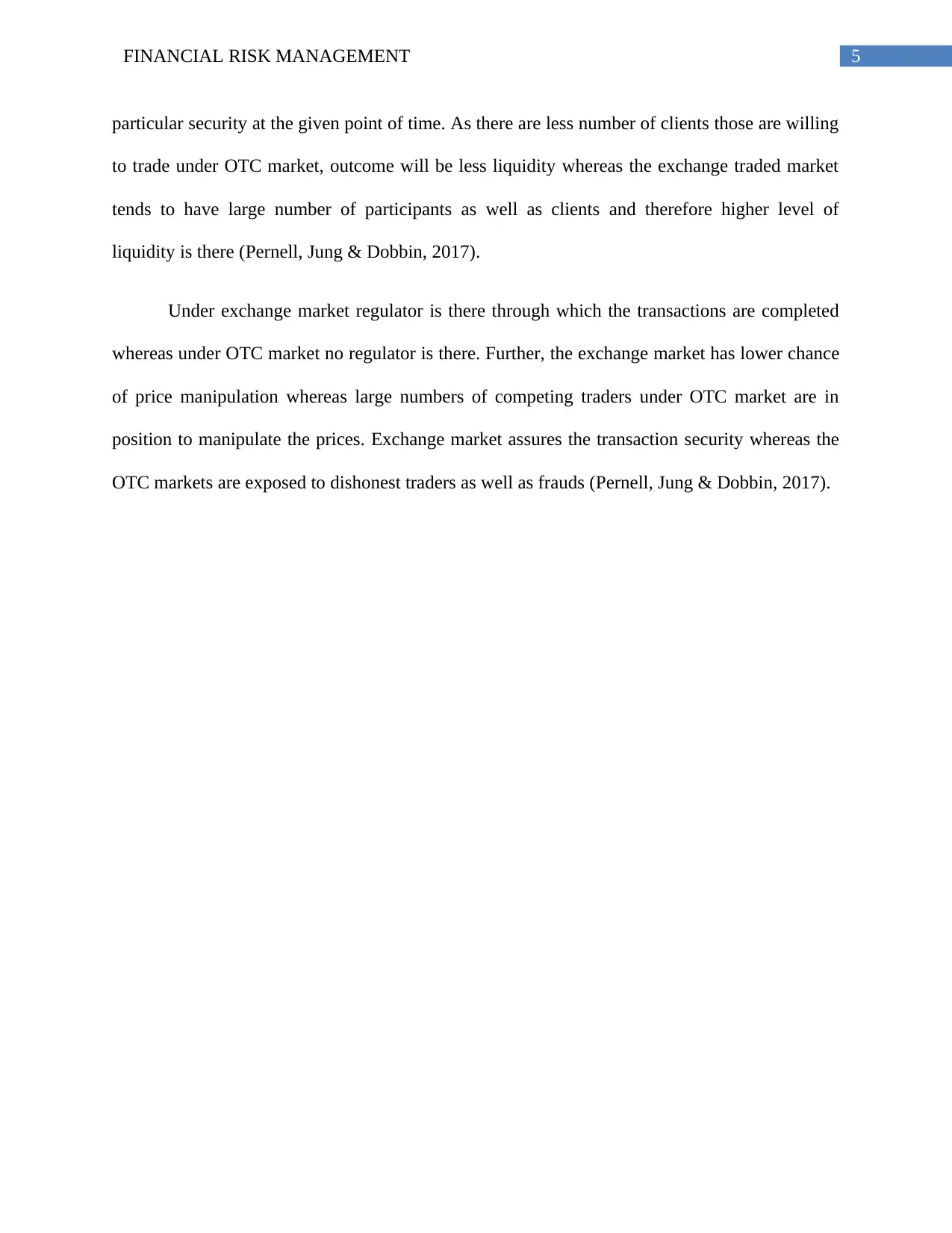
5FINANCIAL RISK MANAGEMENT
particular security at the given point of time. As there are less number of clients those are willing
to trade under OTC market, outcome will be less liquidity whereas the exchange traded market
tends to have large number of participants as well as clients and therefore higher level of
liquidity is there (Pernell, Jung & Dobbin, 2017).
Under exchange market regulator is there through which the transactions are completed
whereas under OTC market no regulator is there. Further, the exchange market has lower chance
of price manipulation whereas large numbers of competing traders under OTC market are in
position to manipulate the prices. Exchange market assures the transaction security whereas the
OTC markets are exposed to dishonest traders as well as frauds (Pernell, Jung & Dobbin, 2017).
particular security at the given point of time. As there are less number of clients those are willing
to trade under OTC market, outcome will be less liquidity whereas the exchange traded market
tends to have large number of participants as well as clients and therefore higher level of
liquidity is there (Pernell, Jung & Dobbin, 2017).
Under exchange market regulator is there through which the transactions are completed
whereas under OTC market no regulator is there. Further, the exchange market has lower chance
of price manipulation whereas large numbers of competing traders under OTC market are in
position to manipulate the prices. Exchange market assures the transaction security whereas the
OTC markets are exposed to dishonest traders as well as frauds (Pernell, Jung & Dobbin, 2017).
⊘ This is a preview!⊘
Do you want full access?
Subscribe today to unlock all pages.

Trusted by 1+ million students worldwide
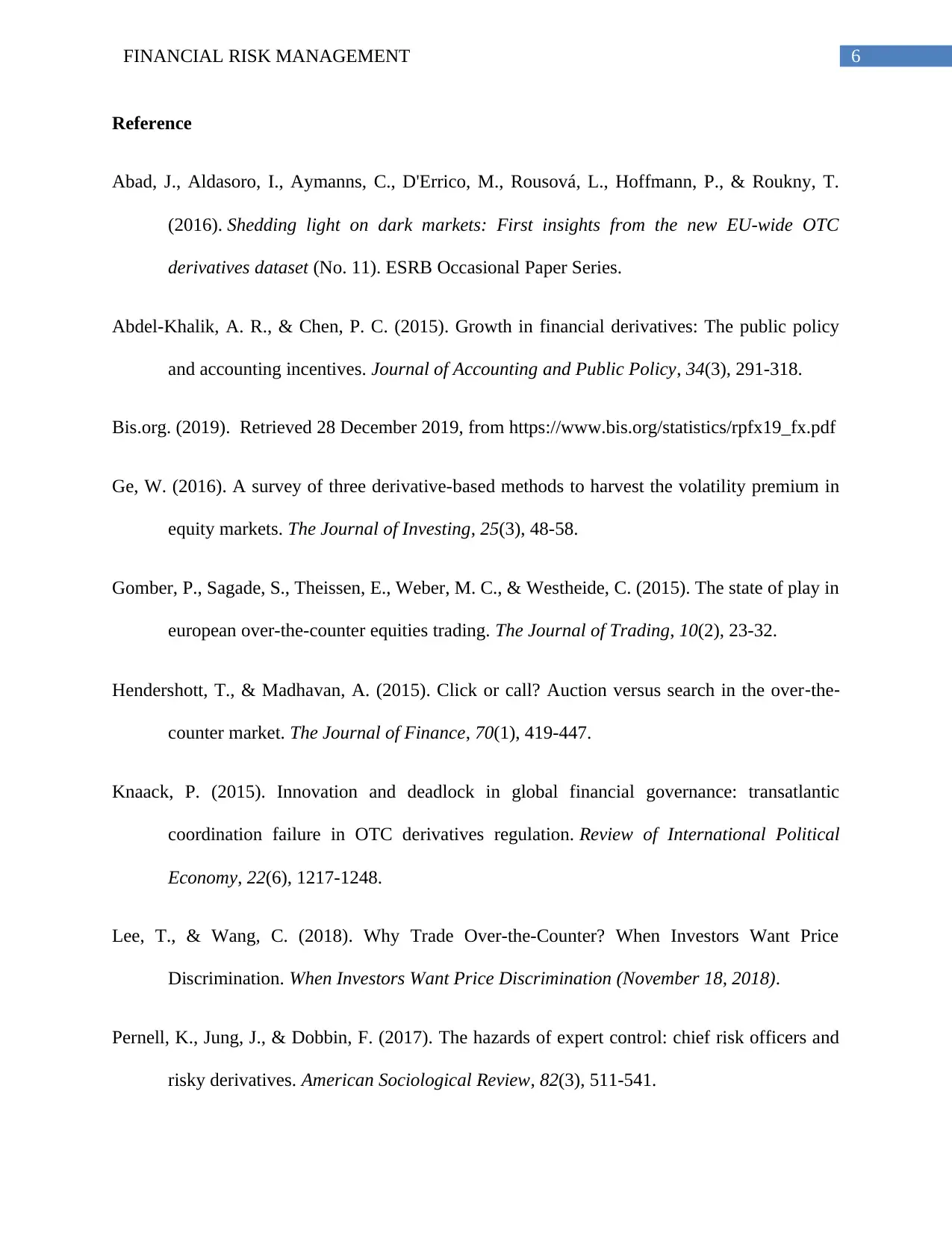
6FINANCIAL RISK MANAGEMENT
Reference
Abad, J., Aldasoro, I., Aymanns, C., D'Errico, M., Rousová, L., Hoffmann, P., & Roukny, T.
(2016). Shedding light on dark markets: First insights from the new EU-wide OTC
derivatives dataset (No. 11). ESRB Occasional Paper Series.
Abdel-Khalik, A. R., & Chen, P. C. (2015). Growth in financial derivatives: The public policy
and accounting incentives. Journal of Accounting and Public Policy, 34(3), 291-318.
Bis.org. (2019). Retrieved 28 December 2019, from https://www.bis.org/statistics/rpfx19_fx.pdf
Ge, W. (2016). A survey of three derivative-based methods to harvest the volatility premium in
equity markets. The Journal of Investing, 25(3), 48-58.
Gomber, P., Sagade, S., Theissen, E., Weber, M. C., & Westheide, C. (2015). The state of play in
european over-the-counter equities trading. The Journal of Trading, 10(2), 23-32.
Hendershott, T., & Madhavan, A. (2015). Click or call? Auction versus search in the over‐the‐
counter market. The Journal of Finance, 70(1), 419-447.
Knaack, P. (2015). Innovation and deadlock in global financial governance: transatlantic
coordination failure in OTC derivatives regulation. Review of International Political
Economy, 22(6), 1217-1248.
Lee, T., & Wang, C. (2018). Why Trade Over-the-Counter? When Investors Want Price
Discrimination. When Investors Want Price Discrimination (November 18, 2018).
Pernell, K., Jung, J., & Dobbin, F. (2017). The hazards of expert control: chief risk officers and
risky derivatives. American Sociological Review, 82(3), 511-541.
Reference
Abad, J., Aldasoro, I., Aymanns, C., D'Errico, M., Rousová, L., Hoffmann, P., & Roukny, T.
(2016). Shedding light on dark markets: First insights from the new EU-wide OTC
derivatives dataset (No. 11). ESRB Occasional Paper Series.
Abdel-Khalik, A. R., & Chen, P. C. (2015). Growth in financial derivatives: The public policy
and accounting incentives. Journal of Accounting and Public Policy, 34(3), 291-318.
Bis.org. (2019). Retrieved 28 December 2019, from https://www.bis.org/statistics/rpfx19_fx.pdf
Ge, W. (2016). A survey of three derivative-based methods to harvest the volatility premium in
equity markets. The Journal of Investing, 25(3), 48-58.
Gomber, P., Sagade, S., Theissen, E., Weber, M. C., & Westheide, C. (2015). The state of play in
european over-the-counter equities trading. The Journal of Trading, 10(2), 23-32.
Hendershott, T., & Madhavan, A. (2015). Click or call? Auction versus search in the over‐the‐
counter market. The Journal of Finance, 70(1), 419-447.
Knaack, P. (2015). Innovation and deadlock in global financial governance: transatlantic
coordination failure in OTC derivatives regulation. Review of International Political
Economy, 22(6), 1217-1248.
Lee, T., & Wang, C. (2018). Why Trade Over-the-Counter? When Investors Want Price
Discrimination. When Investors Want Price Discrimination (November 18, 2018).
Pernell, K., Jung, J., & Dobbin, F. (2017). The hazards of expert control: chief risk officers and
risky derivatives. American Sociological Review, 82(3), 511-541.
Paraphrase This Document
Need a fresh take? Get an instant paraphrase of this document with our AI Paraphraser
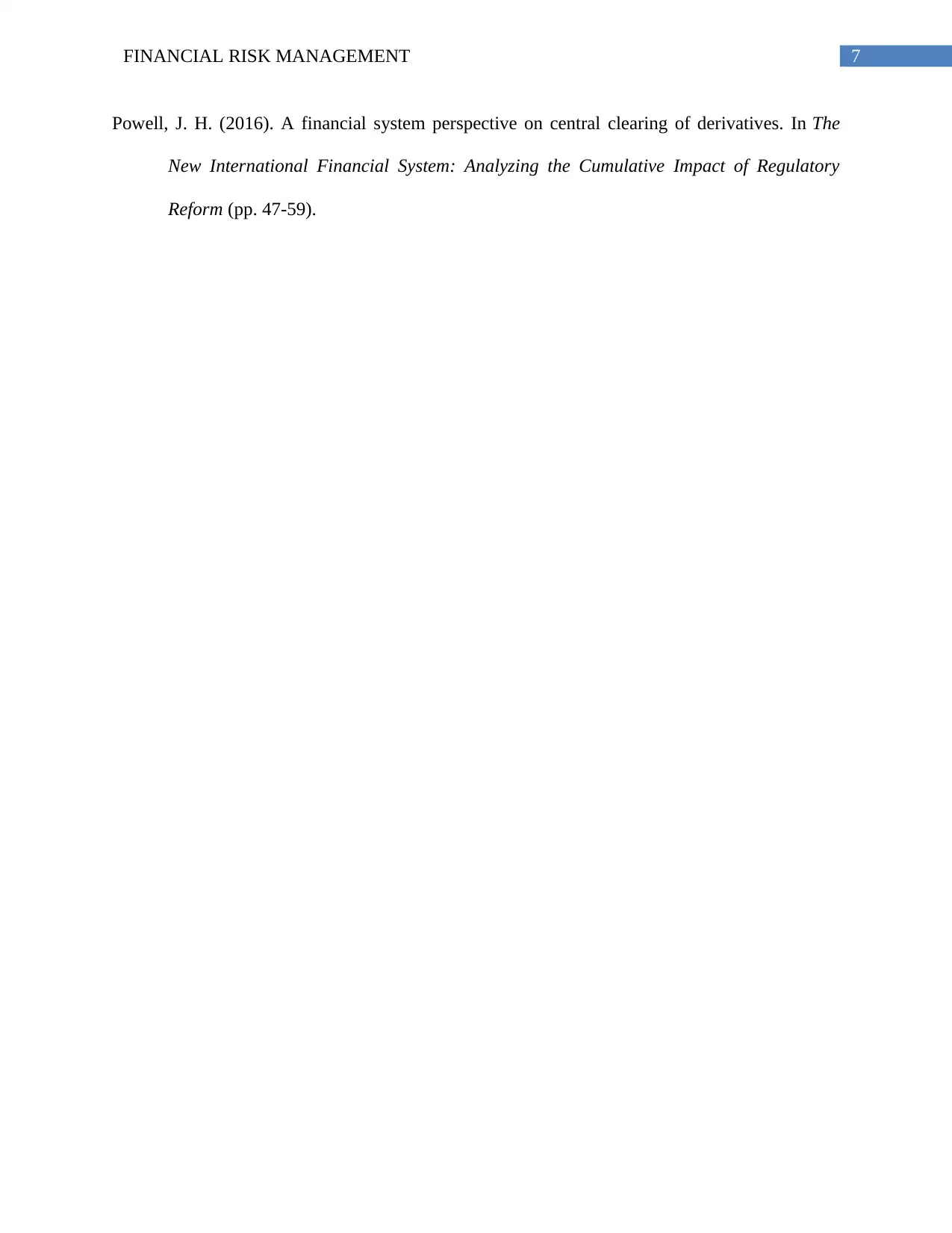
7FINANCIAL RISK MANAGEMENT
Powell, J. H. (2016). A financial system perspective on central clearing of derivatives. In The
New International Financial System: Analyzing the Cumulative Impact of Regulatory
Reform (pp. 47-59).
Powell, J. H. (2016). A financial system perspective on central clearing of derivatives. In The
New International Financial System: Analyzing the Cumulative Impact of Regulatory
Reform (pp. 47-59).

8FINANCIAL RISK MANAGEMENT
⊘ This is a preview!⊘
Do you want full access?
Subscribe today to unlock all pages.

Trusted by 1+ million students worldwide
1 out of 9
Related Documents
Your All-in-One AI-Powered Toolkit for Academic Success.
+13062052269
info@desklib.com
Available 24*7 on WhatsApp / Email
![[object Object]](/_next/static/media/star-bottom.7253800d.svg)
Unlock your academic potential
Copyright © 2020–2025 A2Z Services. All Rights Reserved. Developed and managed by ZUCOL.





